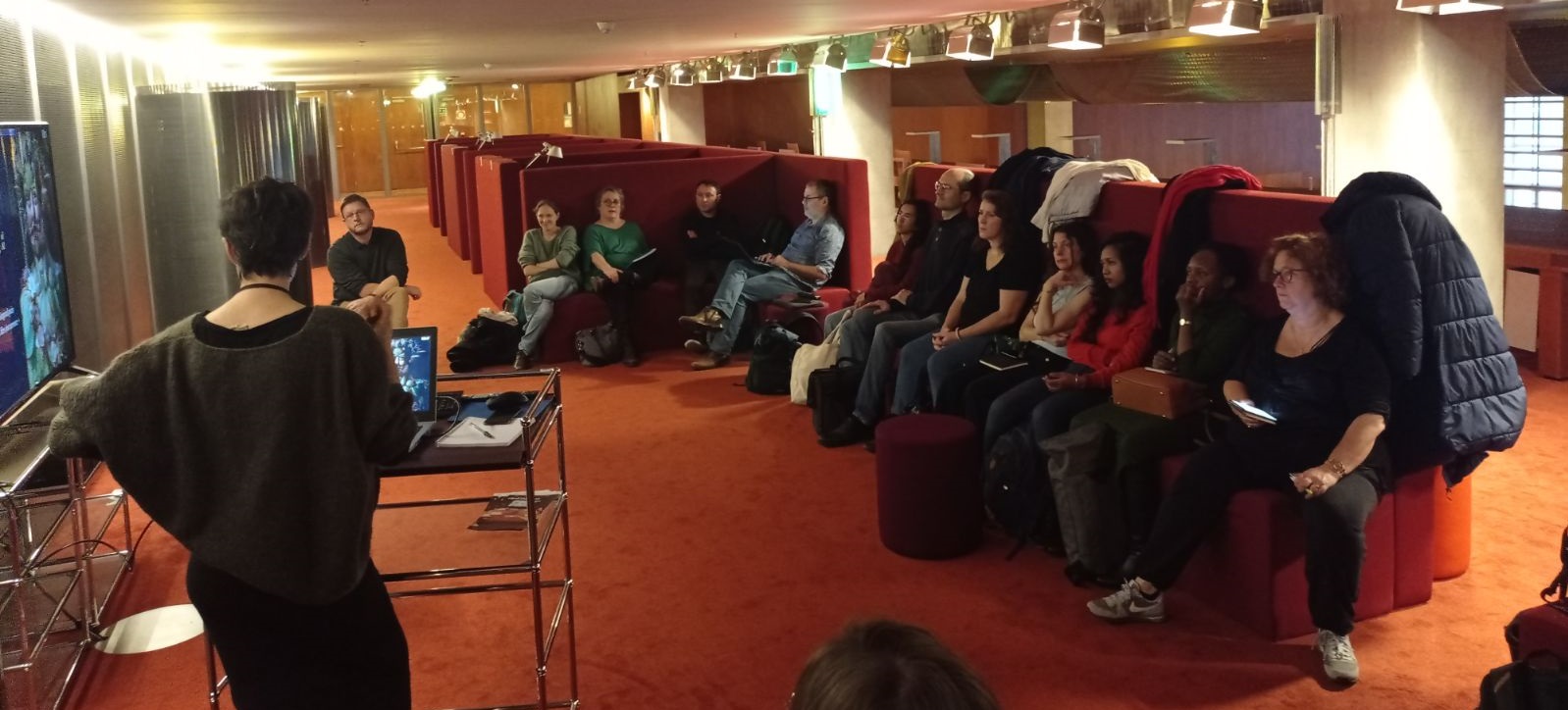18 Sep, 2024
Séminaire Terrains, Analyse et COmparaison des Langues (TACOL)
La prochaine séance de notre séminaire TACOL aura lieu le mardi 08 octobre 2024 à 14h30, sur place (salle de réunion 311, Campus CNRS de Villejuif) et sur Zoom.
Nous aurons le plaisir de recevoir et d’écouter Jesse Hancock-Teed (Universität Bern).
Titre de la présentation :
“The Trans-Mississippian Hypothesis as it Stands Today”
Résumé :
Since at least as early as Sapir (1929), there has been a tradition in the literature arguing that the Iroquoian (iroq1247) and Caddoan (cadd1255) families are genealogically related. Most famously, this grouping was assumed to be a primary sub-branch of the Macro-Siouan hypothesis of Chafe (1976). In the intervening half-century there has been a descriptive and documentary revolution in both Iroquoian and Caddoan linguistics, with most Iroquoian and some Caddoan languages now having basic descriptive materials. In response to that work, the theory was taken up again by Hancock-Teed (2022) and Hancock-Mac Tamhais (2024) where it was named the “Trans-Mississippian Hypothesis.” This presentation will provide a state of the art overview of the hypothesis as it stands today.
The Trans-Mississippian hypothesis rests on around sixty core lexical cognates showing regular sound changes. Building on these correspondences, the talk turns to case studies in the reconstruction of the verbal complex. Particular attention will be paid to the pronominal prefixes, aspectual marking, and derivational suffixes. The talk will close with a forward looking view on the structure of Proto-Trans-Mississippian predicate syntax by proposing that the well-known polysynthetic verbal complexes of the Iroquoian and Caddoan languages were not yet developed by the break up of the proto-language.
Références
Chafe, Wallace L. 1976. The Caddoan, Iroquoian, and Siouan Languages. Vol. State-of-the-Art Reports 3 (Trends in Linguistics). The Hague: The Netherlands: Mouton.
Hancock-Mac Tamhais, J Drew. 2024. Reconstructing the Proto-Trans-Mississippian Pronominal Prefixes. Bismark: USA.
Hancock-Teed, J Drew. 2022. Revisiting Iroquoian and Caddoan: Preliminary Comparison from Inflectional and Derivational Morphology. Charlottesville: USA.
Sapir, Edward. 1929. Central and North American Languages. Encyclopedia Britannica.
Pour toute demande d’information, merci de contacter Lameen Souag
11 Juin, 2024
Séminaire Terrains, Analyse et COmparaison des Langues (TACOL)
La prochaine séance de notre séminaire TACOL aura lieu le lundi 08 juillet 2024 à 14h30, sur place (salle de réunion 311, Campus CNRS de Villejuif) et sur Zoom.
Nous aurons le plaisir de recevoir et d’écouter une présentation en anglais de Valentina Alfarano (post-doctorante à l’Université d’Oslo).
Titre de la présentation :
“Valency morphology and verb classes in Santa Cruz language: a view from Proto-Oceanic”
Résumé :
Reefs-Santa Cruz (RSC) languages, which belong to a primary subgroup of the Oceanic family (Ross & Næss 2007), are spoken in Temotu province, the easternmost province of Solomon Islands. They include Äiwoo, spoken in the Reef Islands, and the three languages of Santa Cruz (SC) Island, namely, Natügu, Nalögo and Engdewu. In the Oceanic literature, RSC languages have always been regarded as “aberrant” (Wurm 1969). Their origins have been debated for more than thirty years until 2007, when they were finally recognised as Oceanic (Ross & Næss 2007). In terms of valency-changing devices and clausal structure, RSC languages as a group show some unusual patterns. On the one hand, Äiwoo is analysed as having a symmetrical voice system with three basic voices, that is, actor voice, undergoer voice, and circumstantial voice (Næss 2021). Symmetrical voice systems are thought to have been lost in the transition from Proto-Malayo-Polynesian to POc (Lynch et al. 2002: 60–62). On the other hand, SC languages display more canonical Oceanic transitivity-based systems, with some valency-changing devices of POc origin.
While some studies have been conducted on the functions and origins of the voice markers in Äiwoo (Næss, 2013, 2021), SC languages still lack a detailed comparative-historical analysis of their valency morphology. The aim of this talk is to analyze the functions and distribution of two SC valency-increasing devices, (v)a- and -ti, reflexes of POc *pa[ka]- and *-i, as well as showing how verb classes evolved over time. I will show that the SC causative (v)a- retained all the causative functions of *pa[ka]-, as well as a non-causative one, namely, marking verb modifiers (Evans 2003). However, unlike *pa[ka]-, (v)a- can also occur with transitive verbs, even though this use has only one attestation in Nalögo. The SC applicative -ti is the affix showing most formal and functional changes in the transition from POc to SC. It retained most functions of POc *-i, but many of them are decaying or decayed. Along with the uses inherited from POc, some innovative functions developed over time. Overall, it seems that the role of POc *-i in deriving transitive verbs is decaying in SC. This phenomenon might have contributed to the emergence of a new class of transitive verbs detransitivized by the prefix (v)ö-, a marker with middle/reciprocal semantics and a possible reflex of POc *paRi- (Lichtenberk 2000, Bril 2005). In the last part of the seminar, time permitting, I will compare the functions of SC valency morphology with the voice and valency markers attested in Äiwoo.
Références
Bril, Isabelle. 2005. Semantic and functional diversification of reciprocal and middle
prefixes in New Caledonian and other Austronesian languages. Linguistic Typology 9:25–76.
Evans, Bethwyn. 2003. A study of valency-changing devices in Proto Oceanic. Canberra: Pacific Linguistics.
Lichtenberk, Frantisek. 2000. Reciprocals without reflexives. In Reciprocals: Forms and functions, ed. by Zygmunt Frajzyngier and Tracy S. Curl, 31–62. Amsterdam/Philadelphia: John Benjamins
Lynch, John & Ross, Malcolm & Crowley, Terry. 2002. The Oceanic Languages. Richmond: Curzon Press.
Næss, Åshild. 2013. From Austronesian voice to Oceanic Transitivity: Äiwoo as the “Missing Link”. Oceanic Linguistics 52(1): 106–124.
———. 2021. Voice and Valency Morphology in Äiwoo. Oceanic Linguistics 60(1), 160–198.
Ross, Malcolm & Næss, Åshild. 2007. An Oceanic Origin for Äiwoo, the Language of the Reef Islands?. Oceanic Linguistics 46(2): 456–498.
Wurm, Stephen Adolphe. 1969. The linguistic situation in the Reef and Santa Cruz Islands. In Papers in the linguistics of Melanesia 2, Pacific Linguistics A-21, 47–105. Canberra: The Australian National University.
Pour toute demande d’information, merci de contacter Yann Le Moulec
30 Mai, 2024

Datathon de la parole, 18-19 novembre 2024 :
dépôt, archivage et diffusion des corpus oraux
(linguistique, socio-linguistique, histoire orale)
Le Groupement de recherche « Linguistique Informatique, Formelle et de Terrain » (GDR LIFT), la plate-forme Collection de Corpus Oraux Numériques (Cocoon) et la Bibliothèque nationale de France organisent à Paris dans les espaces du DataLab de la Bibliothèque nationale de France un troisième atelier « Datathon de la parole » de quatre demi-journées, du lundi 18 novembre au mardi 19 novembre 2023. Il fait suite aux deux datathons de la parole qui ce sont déroulés en novembre 2021 à Orléans et novembre 2023 à Paris (BnF).
L’événement s’inscrit également dans le cadre des activités soutenues par le consortium « Corpus, Langues et Interactions » (CORLI) de l’Infrastructure de Recherche Huma-Num et par l’Institut des Langues Rares (ILARA) de l’École Pratique des Hautes Études.
L’appel à participation est ouvert à tous les chercheurs, chercheuses et doctorant·e·s qui ont un jeu de données orales et souhaitent en ouvrir l’accès (à diverses fins, y compris sa ré-utilisation à des fins de recherche nouvelles).
Objectifs
L’atelier se propose de fournir un cadre dans lequel travailler à la description des ressources et de leur contexte de production, en vue d’une publication des données. Cet atelier sera encadré de présentations générales par les animateurs et le BnF DataLab, visant à situer les enjeux et stratégies, dans un contexte de Science ouverte : dépôt, archivage et diffusion ; description des données et référencement ; articulation entre données, outils et publications ; fouille de données.
Les thématiques abordées couvrent les finalités aussi bien que les dimensions spécifiques du plan de gestion de données que sont le plan de classement, le plan de nommage, le formatage et autres étapes qui permettent d’aboutir au dépôt en archive dans les règles de l’art, dépôt qui ouvre les données à de nouvelles utilisations et recherches, dans une logique cumulative.
Inscription
Informations souhaitées par le comité d’organisation du datathon de la parole
Nature des données orales (parlées), langues concernées (on donnera une priorité aux langues peu documentées de tous les continents) ;
Description succincte du projet scientifique dans le cadre duquel les données ont été collectées ;
Description des données : type de données, format et quantité (des données primaires : les enregistrements audio et/ou vidéo, ainsi que des données secondaires : transcription, annotation, traduction) ;
Perspectives d’enrichissement futur.
Date limite d’inscription et de dépôt du dossier : 15 juillet 2024, en remplissant le formulaire suivant https://framaforms.org/datathon-de-la-parole-2024-1718364957
Nombre maximum de participants : 15
Les participants dont les dossiers auront été retenus seront contactés fin juillet par les animateurs.
Pour plus d’informations, veuillez consulter le site internet de l’atelier : BnF Datalab
Lieu
Bibliothèque nationale de France – Site Tolbiac/François Mitterrand, Quai François Mauriac, Paris. Métro ligne 14 : Bibliothèque François Mitterrand, ou métro ligne 6 : Quai de la Gare.
Ressources
Organisateurs
Flora Badin (LLL), Séverine Guillaume (LACITO), Michel Jacobson (Huma-Num), Audrey Viault (BnF), Fabrice Menneteau (BnF), Louise-Anne Charles (BnF-Datalab), Alexis Michaud (LACITO), Balthazar Do Nascimento (LACITO).






